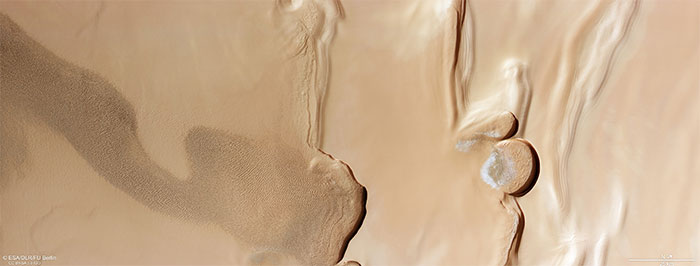Europe's Mars Express spacecraft captured images of 'shocks' on Mars
New data from the Mars Express spacecraft not only reveals the "source of life" on Mars, but also a piece of the planet's lost history.
According to Sci-News, images and other data that Mars Express obtained while flying across the North Pole of Mars show that the permanent ice cap here is a stack of layers of water ice and dust up to 3km thick, about 1,000km in diameter. .
They are divided into four stacked thick layers of varying thickness, each thick layer consisting of many finer thin layers.

Planum Boreum, an interesting area full of water ice at the North Pole of Mars - (Photo: ESA).
Like "story-telling" tree rings , these sediments contain information about the climate over millions of years on Mars.
Each deposit is a precipitation of atmospheric dust and water and is caused by direct frost formation. They consist mainly of water ice, with fine dusty sediments accounting for 10 to 15% of the total.
According to the European Space Agency (ESA), the "owner" of the Mars Express orbiting Mars, the new data reflects changes in the Martian orbit as well as the tilt of the planet's rotation axis.
Our Earth sometimes changes its orbit slightly, shifting its axis of rotation. But the instability of Mars is even higher, possibly showing that the world's climate during many periods of change is even more severe. Earth.
Because the change in rotation axis leads to changes in solar radiation for each point on the planet, especially at the poles.
In its current location, the North Pole's ice cap is growing strongly. It will completely disappear in the summer.
"The terrain around the north pole of Mars, called Planum Boreum , is fascinating," the ESA team wrote.
In the photo they just released, the left side is dominated by a vast, elongated stretch of undulating sand dunes, stretching more than 150km in just this frame.
This wrinkled, chaotic appearance contrasts greatly with the flatter and more pristine terrain visible to the right.
Meanwhile, the smooth area with no obvious signs of erosion and not cratered by rocks flying from space is a sign that the surface is very young, possibly even ancient. annual rejuvenation.
"Between these two extremes there are two semicircular cliffs, the larger of which is about 20km wide. Inside the curved part of these cliffs are frost-covered sand dunes."
These are called polar troughs , a feature created when wind blows in and wears away the surface.
Not only strange and interesting, detailed data about an area with water ice is the "treasure" that Mars Express sent to Earth people.
In the future, leading space agencies such as NASA and ESA plan to establish a Mars base. At that time, water ice will become the "source of life", where they can find ways to turn into living water and fuel.
Furthermore, the presence of water on another planet is necessary to infer that the planet is habitable.
With current scientific evidence, most scientists believe that Mars once had life several billion years ago, when its climate was similar to Earth's and had not yet been affected by evolution. unfortunate planet turns harsh.
Some scientists even still hope that some extreme life form, to this day, still lurks somewhere on this planet.
- Mars landscape through 3D images
- Mars Express prepares to approach the moon Mars
- Disclosure is little known about the plan to explore ice on Mars
- NASA explains strange images on Mars
- Overwhelmed with the latest images of Mars
- How did Mars ever flood?
- More evidence that Mars had life
- Mars spacecraft upgraded after 20 years of using Windows 98
- The UAE is about to launch a spacecraft to Mars
- Beautiful ultraviolet surface of Mars from satellite images
- Christmas on Mars: ESA publishes beautiful pictures of snow and ice on Red Planet
- Indian spacecraft coming to Mars
 Announced 3 houses on the Moon and Mars
Announced 3 houses on the Moon and Mars Science proves: Mars also knows 'deflated'
Science proves: Mars also knows 'deflated' Elon Musk announced the price for a Mars trip was 11.6 billion VND, free of charge
Elon Musk announced the price for a Mars trip was 11.6 billion VND, free of charge NASA discovered strange 'gate' on Mars, is the hiding place found?
NASA discovered strange 'gate' on Mars, is the hiding place found?